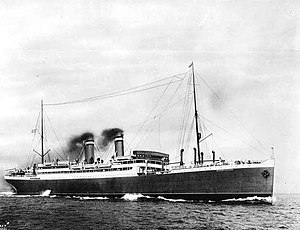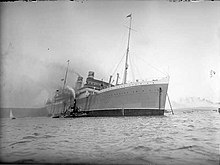
RMS Empress of Russia was a steam turbine ocean liner built in 1912–13 by Fairfield Shipbuilding & Engineering Company at Govan on the Clyde in Scotland for Canadian Pacific steamships (CP). She regularly worked the trans-Pacific route between Canada and the Far East.

RMS Aquitania was a British ocean liner of the Cunard Line in service from 1914 to 1950. She was designed by Leonard Peskett and built by John Brown & Company in Clydebank, Scotland. She was launched on 21 April 1913 and sailed on her maiden voyage from Liverpool to New York on 30 May 1914. Aquitania was the third in Cunard Line's grand trio of express liners, preceded by RMS Mauretania and RMS Lusitania, and was the last surviving four-funnelled ocean liner. Shortly after Aquitania entered service, World War I broke out, during which she was first converted into an auxiliary cruiser before being used as a troop transport and a hospital ship, notably as part of the Dardanelles Campaign.
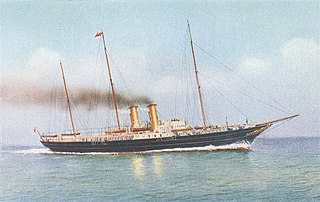
HMY Alexandra was a steamship built as a British royal yacht, completed in 1908. Normally transporting Britain's royal family to European ports, Alexandra served as a hospital ship during the First World War. After 17 years of British service, she was sold to Norwegian commercial interests in 1925. Renamed Prins Olav, she was first used as a luxury cruise ship on trips to the North Cape, she was converted to take more passengers and cargo. In 1937 she began sailing as a Hurtigruten passenger/cargo ship along the coast of Norway. After being requisitioned by the Norwegian government following the 9 April 1940 German invasion of Norway, she transported troops for the Norwegian war effort. Prins Olav was sunk by German bombers on 9 June 1940, while attempting to escape to the United Kingdom as the Norwegian Campaign was coming to an end.

RMS Empress of Britain was a transatlantic ocean liner built by the Fairfield Shipbuilding and Engineering Company at Govan on the Clyde in Scotland in 1905–1906 for Canadian Pacific Steamship (CP). This ship – the first of three CP ships to be named Empress of Britain – regularly traversed the transatlantic crossing between Canada and Europe until 1923, with the exception of the war years. Empress of Britain was the sister ship of RMS Empress of Ireland, which was lost in 1914.

The RMS Teutonic was an ocean liner built for the White Star Line in Belfast and was the first armed merchant cruiser.
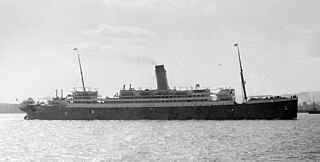
SS Megantic was a UK transatlantic ocean liner that was built in Ireland and launched in 1908. She was one of a pair of sister ships that were ordered in 1907 by Dominion Line but completed for White Star Line.

SS Kristianiafjord was the first ship in the fleet of the Norwegian America Line, built by Cammell Laird in Birkenhead, UK. The name refers to the fjord leading into the Norwegian capital Oslo, at the time called Kristiania. Launched from its shipyard on 23 November 1912, it was put into service in 1913, the same year as its sister ship, SS Bergensfjord. It embarked on its maiden voyage on 4 June that year, sailing from Christiania (Oslo) through Christiansand, Stavanger and Bergen to New York, with the captain S. C. Hiortdahl. Kristianiafjord had a tonnage of 10,699, and was fitted with wireless and electric light. She could take 1,200 passengers – 100 first class, 250 second class and 850 third class.

SS Dwinsk was a transatlantic ocean liner that was launched in Ireland in 1897 as Rotterdam, renamed C. F. Tietgen in 1906, and renamed Dwinsk in 1913. A U-boat sank her in 1918, with the loss of 23 lives. The ship was built for Holland America Line, but was successively owned by Scandinavian America Line and Russian American Line, and after the Russian Revolution she was managed by Cunard Line.

RMS Orion was an ocean liner launched by the Orient Steam Navigation Company in 1934 and retired from the water in 1963 after carrying about 500,000 passengers. A 23,371 ton passenger ship, the Orion was built to carry 486 first class, 653 tourist class and 466 crew passengers from Europe through the Pacific to Australia. The construction of the ship was documented in Paul Rotha's 1935 film Shipyard.
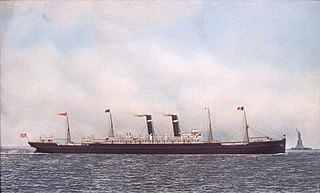
SS Finland was an American-flagged ocean liner built in 1902 for the Red Star Line. During World War I she served as a transport for the United States Navy named USS Finland (ID-4543). Before her Navy service in 1917, she was also USAT Finland for the United States Army.

SS Kroonland was an ocean liner for International Mercantile Marine (IMM) from her launch in 1902 until she was scrapped in 1927. Kroonland was the sister ship of Finland and a near sister ship of Vaderland and Zeeland of the same company. Kroonland sailed for IMM's Red Star Line for 15 years, and also sailed for IMM's American Line and Panama Pacific Line. During World War I, the ship served as United States Army transport USAT Kroonland through April 1918, and as the Navy auxiliary USS Kroonland (ID-1541) from April 1918 to October 1919.

SS Prinz Friedrich Wilhelm was an ocean liner for North German Lloyd (NDL) from her launch in 1907 until the end of World War I. After the war, she briefly served as USS Prinz Friedrich Wilhelm (ID-4063) for the United States Navy returning American troops from France. The vessel was first chartered—and later purchased outright—by Canadian Pacific Steamships (CP) and operated under the names Empress of China, Empress of India, Montlaurier, Monteith, and Montnairn. She was scrapped in 1929.

USS Rijndam (ID–2505) was the Holland America Line (HAL) ocean liner Rijndam, also spelt Ryndam, which was launched in Ireland in 1901 and scrapped in the Netherlands in 1929. The US requisitioned her as the United States Navy troopship USS Rijndam from 1918 until 1919. She was the first of four Holland America Line ships to be called Ryndam.

SS Zeeland was a British and Belgian ocean liner of the International Mercantile Marine Co. (IMM). She was a sister ship to Vaderland and a near sister ship to Kroonland and Finland of the same company. Although her name was Dutch, it was changed during World War I to the less German-sounding SS Northland. She served for a time as a British troop ship under the name HMT Northland. Reverting to Zeeland after the war, the ship was renamed SS Minnesota late in her career. Zeeland sailed primarily for IMM's Red Star Line for most of her early career, but also sailed under charter for the White Star Line, the International Navigation Company, the American Line, and the Atlantic Transport Line, all IMM subsidiary lines. The pursers safe survived the scrapyard at Inverkeithing and after residing in a wardrobe for 80 years is currently on display in a local private home.

SSCzar was an ocean liner for the then Russian American Line before World War I. In 1920-1930, the ship was named Estonia for the Baltic American Line, then named Pułaski for the PTTO and as a UK Ministry of War Transport troopship, and as Empire Penryn after World War II. The liner was built in Glasgow for the Russian American Line in 1912 and sailed on North Atlantic routes from Liepāja (Libau) to New York. On one eastbound voyage in October 1913, Czar was one of ten ships that came to the aid of the burning Uranium Line steamer Volturno.

SS Statendam was a transatlantic ocean liner that was launched in Ireland in 1898 for Holland America Line. She was the first of several ships in the company's history to be called Statendam. She was NASM's first ship of more than 10,000 GRT, and she was the largest ship in the company's fleet until Potsdam was completed in 1900.

SS Lapland was a steam ocean liner built in Ireland for the Belgian Red Star Line, as Red Star's flagship, similar in appearance to the fellow liners SS Samland, SS Gothland and SS Poland, but far larger. She was a half sister to White Star Line's "Big Four." They were similar in many ways, such as the island bridge, 4 masts, 2 funnels. But Lapland had a less luxurious interior.

The America class was the replacement for the Britannia class, the Cunard Line's initial fleet of wooden paddle steamers. Entering service starting in 1848, these six vessels permitted Cunard to double its schedule to weekly departures from Liverpool, with alternating sailings to New York. The new ships were also designed to meet new competition from the United States.

SS Westernland was a transatlantic ocean liner that was launched as Regina in Scotland in 1917, renamed Westernland in 1929 and was scrapped in 1947. She began her career as a troop ship repatriating US troops after the Armistice of 11 November 1918. In the Second World War, Westernland served as a troop ship, repair ship and destroyer depot ship.

SS Minnekahda was a transatlantic ocean liner that was launched in Ireland in 1917 and scrapped in Scotland in 1936. She was laid down in 1914 but the First World War delayed her completion. Because of the war she was completed in 1918 as a troop ship, and then worked as a cargo ship.
